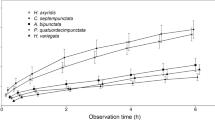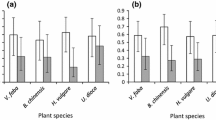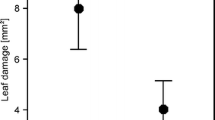Abstract
A series of laboratory experiments was conducted to determine the effect of interspecific differences on prey defensive behavior on the susceptibility of two aphid species (Acyrthosiphon pisum and A. kondoi) to a ground-foraging predator, Harpalus pennsylvanicus, and a foliar-foraging predator, Coccinella septempunctata. These organisms are representative of a biologically and economically important predator/prey system in alfalfa. The primary defensive behavior of both aphid species toward C. septempunctata was to “drop” from the plant. Both aphid species were significantly more likely to drop from the plant in the presence of C. septempunctata. However, when C. septempunctata was present, a significantly lower proportion of A. kondoi individuals dropped (0.42 ± 0.07) compared to A. pisum (0.73 ± 0.08). As a result of their lower propensity to drop from the plant A. kondoi individuals are significantly more likely to be consumed by C. septempunctata. Conversely, the higher propensity of A. pisum individuals to drop increased their susceptibility to ground-foraging predators. When A. pisum was the prey species, ground-foraging predators made a significant contribution to overall aphid suppression and there was a significant synergistic interaction between ground and foliar-foraging predators. When A. kondoi was the prey there was no interaction between the predator species. As either a cause or consequence of its higher propensity to drop, A. pisum seems to be more adapted for survival and dispersal off the plant. In comparison to A. kondoi individuals, A. pisum individuals relocate plants more quickly (63 ± 41 s vs. 164 ± 39 s), disperse farther (18 ± 1.7 cm vs. 13 ± 0.66 cm), and survive longer (37 ± 2.0 h vs. 25 ± 2.0) off the plant. This study demonstrates the importance of prey defensive behavior in determining the susceptibility of a prey species to a multiple-predator complex.
Similar content being viewed by others
Author information
Authors and Affiliations
Additional information
Received: 24 February 1997 / Accepted:17 December 1997
Rights and permissions
About this article
Cite this article
Losey, J., Denno, R. Interspecific variation in the escape responses of aphids: effect on risk of predation from foliar-foraging and ground-foraging predators. Oecologia 115, 245–252 (1998). https://doi.org/10.1007/s004420050513
Issue Date:
DOI: https://doi.org/10.1007/s004420050513




